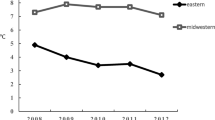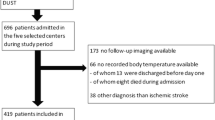Abstract
Studies suggest that there is an association between weather patterns and ischemic stroke risk. Exposure to a sudden decrease in temperature may increase stroke risk through altering blood viscosity and/or by triggering infections. We investigated the association between ischemic stroke risk and change in temperature. We used a case-crossover study design with 303 consecutive patients admitted to Heidelberg University, Department of Neurology over a one and a half year period (Aug 1998–Jan 2000). We used one day before stroke as the hazard (case) period matched to two control periods 2–7 days before and after stroke onset and took both ambient maximum temperature and the 24-hour difference in maximum temperature as exposure. There was no risk associated with ambient maximum temperature at all lag times and in all subgroup analyses. For the 24-hour difference, large changes in temperature (>5 °C) were associated with an increased risk of acute ischemic stroke regardless of whether the change was negative or positive. The odds ratio for temperature increases >5 °C compared to no change in temperature was 2.0 (95% confidence interval (CI): 0.7–5.9) at a lag time of 3 days. We found no relevant relation between temperature and stroke risk. The results suggest that the risk of ischemic stroke may increase with large day-to-day variations upwards or downwards in temperature.
Similar content being viewed by others
References
ZY Chen SF Chang CL Su (1995) ArticleTitleWeather and stroke in a subtropical area: Ilan Taiwan Stroke 26 569–572 Occurrence Handle7709398
D Jakovljevic V Salomaa J Sivenius et al. (1996) ArticleTitleSeasonal variation in the occurrence of stroke in Finnish adult population. The FINMONICA Stroke Register. Finnish monitoring trends and determinants in cardiovascular disease Stroke 26 1774–1779
JD Lanska RG Hoffman (1999) ArticleTitleSeasonal variation in stroke mortality rates Neurology 52 984–988 Occurrence Handle10102417
M Kelly-Hayes PA Wolf CS Kase FN Brand JM McGuirk RB D’Agostino (1995) ArticleTitleTemporal patterns of stroke onset – The Framingham study Stroke 26 1343–1347 Occurrence Handle7631334
AL Oberg JA Ferguson LM McIntyre RD Horner (2000) ArticleTitleIncidence of stroke and season of year: Evidence of an association Am J Epidemiol 152 558–564 Occurrence Handle10.1093/aje/152.6.558 Occurrence Handle10997546
LS Kalkstein JS Greene (1997) ArticleTitleAn evaluation of climate/mortality relationship in large US cities and the possible impacts of a climate change Environ Health Perspect 105 84–93 Occurrence Handle9074886
VL Feigin YP Nikitin ML Bots TE Vinogradova DE Grobbee (2000) ArticleTitleA population-based study of the associations of stroke occurrence with weather parameters in Siberia, Russia (1982–92) Eur J Neurol 7 171–178 Occurrence Handle10.1046/j.1468-1331.2000.00016.x Occurrence Handle10809937
ML Gorjanc WD Flanders J Derslice ParticleVan J Hersh J Malilay (1999) ArticleTitleEffects of temperature and snowfall on mortality in Pennsylvania Am J Epidemiol 149 1152–1160 Occurrence Handle10369510
ST Field DM Hill (2002) ArticleTitleWeather, Chinook and stroke occurrence Stroke 33 1751–1757 Occurrence Handle10.1161/01.STR.0000020384.92499.59
MD Connor (2002) ArticleTitleDoes the weather influence stroke incidence? (Editorial comment) Stroke 33 1757–1759 Occurrence Handle12532956
PJ Neild D Syndercombe-Court WR Keatinge GC Donaldson M Mattock M Caunce (1994) ArticleTitleCold induced increases in erythrocyte count, plasma cholesterol and plasma fibrinogen of elderly people without a comparable rise in protein C or factor X Clin Sci (London) 86 43–84
WR Keatinge SR Coleshaw F Cotter M Mattock M Murphy R Chelliah (1984) ArticleTitleIncreases in platelet and red cell counts, blood viscosity and arterial pressure during mild surface cooling: Factors in mortality from coronary and cerebral thrombosis in winter Br Med J 289 1405–1408
WR Keatinge GC Donaldson (1995) ArticleTitleCardiovascular mortality in winter Arctic Med Res 54 IssueIDSuppl 2 16–18 Occurrence Handle8900826
H Becher A Grau K Steindorf F Buggle W Hacke (2000) ArticleTitlePrevious infection and other risk factors for acute cerebrovascular ischemia: Attributable risks and the characterisation of high risk groups J Epidemiol Biostat 5 277–283 Occurrence Handle11142603
AJ Grau F Buggle S Heindl et al. (1995) ArticleTitleRecent infection as a risk factor for cerebrovascular ischemia Stroke 26 373–379 Occurrence Handle7886709
A Grau H Buggle H Becher et al. (1998) ArticleTitleRecent bacterial and viral infection is a risk factor for cerebrovascular ischemia Neurology 50 196–203 Occurrence Handle9443480
G Bucurescu DD Stieritz (2003) ArticleTitleEvidence of an association between Chlamydia pneumoniae and cerebrovascular accidents Eur J Neurol 10 449–452 Occurrence Handle10.1046/j.1468-1331.2003.00605.x Occurrence Handle12823500
R Eccles (2002) ArticleTitleAcute cooling of the body surface and the common cold Rhinology 40 109–114 Occurrence Handle12357708
R Eccles (2002) ArticleTitleAn explanation for the seasonality of acute upper respiratory tract viral infections Acta Otolaryngol 122 183–191 Occurrence Handle10.1080/00016480252814207 Occurrence Handle11936911
YC Hong JH Rha JT Lee EH Ha HJ Kwon H Kim (2003) ArticleTitleIschemic stroke associated with decrease in temperature Epidemiology 14 473–478 Occurrence Handle12843774
YC Hong JH Rha JT Lee EH Ha HJ Kwon H Kim (2004) ArticleTitleIschemic stroke associated with decrease in temperature Epidemiology 15 126–127 Occurrence Handle10.1097/01.ede.0000100146.24974.ef Occurrence Handle14712158
A Grau H Becher CM Ziegler et al. (2004) ArticleTitlePeriodontal disease as a risk factor for ischemic stroke Stroke 35 496–501 Occurrence Handle10.1161/01.STR.0000110789.20526.9D Occurrence Handle14707235
InstitutionalAuthorNameSAS Institute Inc. (2001) SAS/STAT Software: Release 8.2. Cary SAS Institute Inc. NC
Author information
Authors and Affiliations
Corresponding author
Rights and permissions
About this article
Cite this article
Kyobutungi, C., Grau, A., Stieglbauer, G. et al. Absolute Temperature, Temperature Changes and Stroke Risk: A Case-Crossover Study. Eur J Epidemiol 20, 693–698 (2005). https://doi.org/10.1007/s10654-005-0703-x
Accepted:
Issue Date:
DOI: https://doi.org/10.1007/s10654-005-0703-x




